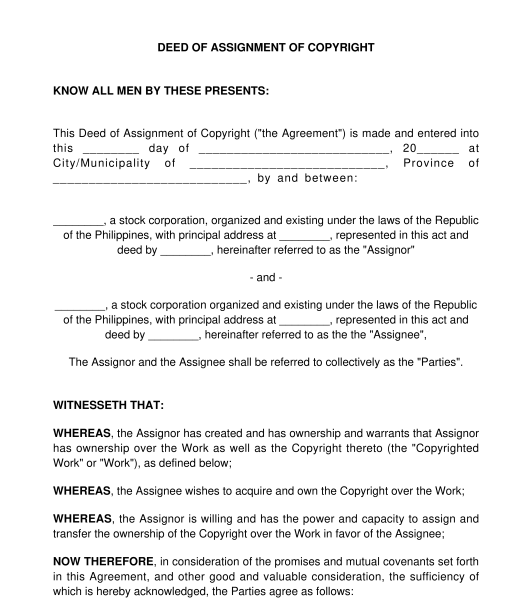 09/26/2025
09/26/2025

Answer a few questions and your document is created automatically.

Your document is ready! You will receive it in Word and PDF formats. You will be able to modify it.

 09/26/2025
09/26/2025
 Word and PDF
Word and PDF
 6 to 9 pages
6 to 9 pages
A Deed of Assignment of Copyright is an agreement entered into by two persons, called the assignor and the assignee. With this agreement, the assignor being the owner of the copyright transfers ownership of the copyright over a certain work or works in favor of the assignee.
Copyright refers to intellectual property that is protected by law and protects the author's right over his works. Works that may be protected include literary, scientific, and artistic work, that requires at least some form of creative expression from the author. Examples of these are writings, musical works, films and photographic works, ornamental designs or models of manufacture, paintings, sculptures, and other works of art, as well as computer programs and mobile apps, etc. Assignment of copyright entails the protection of economic rights:
Economic Rights. This pertains to the exclusive privilege granted to the creator or author, or to the assignee (pursuant to a Deed of Assignment of Copyright) in terms of economic advantage. These rights allow the creator or author (or assignee) to control how he/she will obtain profit or economic gain which includes control over activities like reproducing the work, distributing it, publicly displaying or performing it, and creating adaptations or derivative works based on the original. This is to be distinguished from moral rights which only pertain to the original author or creator of the work notwithstanding an assignment made in favor of another.
Moral Rights. This serves to protect the creator or author of the work with respect to non-economic interests in their work, ensuring due credit and protecting the work from alterations that might harm the creator or author's reputation. This means that if the work is used whether in whole or in part, the creator or author should be given recognition, credit, or at least mentioned.
This agreement sets forth the terms and conditions of the transfer of ownership of the copyright by the assignor in favor of the assignee and may include payment of a sum of money, and an option to provide certain restrictions with the assignment of copyright.
If the assignor does not want to transfer ownership of the copyright and merely wants to allow the assignee to use the copyright, then an Intellectual Property License Agreement may be used.
The following information is necessary to complete the document:
If there will be attachments to the document, such as the authorizations for the representatives and copy of the certificates of copyright registration, said documents should be attached to the Deed of Assignment of Copyright. Once the document is complete (including the attachments), the Assignor and the Assignee, or their authorized representatives, should print and sign at least one copy for each party.
If the document will be acknowledged, the parties (or their respective representatives) should present themselves before a notary public with all the original copies of the document and their attachments. The parties (or their respective representatives) should also bring a competent form of identification, such as a passport or driver's license.
If the document is acknowledged, the notary public will keep one original copy of the document. Both parties should each keep a copy of the document for their records.
Registration or Recording
It is generally not mandatory to register the Deed of Assignment of Copyright. However, registration with the Intellectual Property Office of the Philippines (IPOPHL) would ensure more protection of the copyright.
The Intellectual Property Code of the Philippines is the primary law that governs Deeds of Assignment of Copyright. However, the laws on contracts and obligations in the Civil Code of the Philippines may also apply.
Under the Intellectual Property Code, Licensing Agreements that comply with the provisions of Sections 86 and 87 thereof don't need to be registered with the Documentation, Information, and Technology Transfer Bureau ("DITTB"). However, if it is later found that the Licensing Agreement does not comply with Sections 87 and 88 of the Intellectual Property Code, then the entire agreement will be unenforceable under Philippine Law.
You fill out a form. The document is created before your eyes as you respond to the questions.
At the end, you receive it in Word and PDF formats. You can modify it and reuse it.
A guide to help you: What to do after Creating a Contract?
Deed of Assignment of Copyright - sample template
Country: Philippines